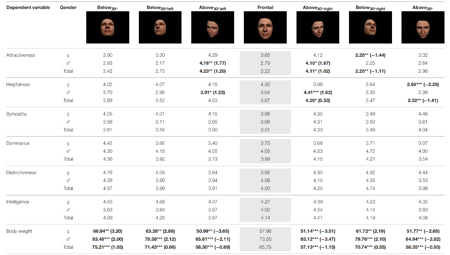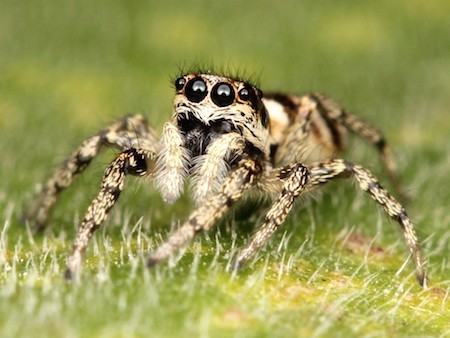Marc Abrahams's Blog, page 218
June 12, 2017
Which individuals become fatter when they practice exercise? (study)
 Professor Jean-Frédéric Brun of the Service Central de Physiologie Clinique, Centre d’Exploration et de Réadaptation des Anomalies du Métabolisme Musculaire (CERAMM), Montpellier, France, has spent almost half of his life writing research or tutorial papers which deal with exercise, fuel metabolism assessment in vivo, and hemorheology.
Professor Jean-Frédéric Brun of the Service Central de Physiologie Clinique, Centre d’Exploration et de Réadaptation des Anomalies du Métabolisme Musculaire (CERAMM), Montpellier, France, has spent almost half of his life writing research or tutorial papers which deal with exercise, fuel metabolism assessment in vivo, and hemorheology.
He has recently investigated a paradox which has, surprisingly, received little attention – namely, ‘Which individuals become fatter when they practice exercise?’
“It is well established that high volumes (15–20h/week) of physical activity at intensities>60% VO2max , as well as low volumes (2–3hrs/wk) of low intensity exercise targeted in the zone of the LIPOXmax (around 40% VO2max ) allow a significant and prolonged loss of fat mass. By contrast it is not uncommon to observe patients whose fat mass increases when they practice low volumes of activity at intensity around or above 60% VO2max . This paradoxical situation has surprisingly retained little attention. [our emphasis] ”
He and his investigative team revealed, by experiment, that :
“All these patients that gain weight during exercise training perform low volumes (2–3h/wk) of exercise that are clearly targeted above the lipid oxidation zone. These subjects describe feelings of increased hunger after exercise, with or without binging and nibbling. When exercise is performed immersed in water it also appears to stimulate appetite and to result in weight gain in some individuals. Therefore, paradoxical weight gain due to low volume of exercise at >60% VO2max is not uncommon, although it seems a priori illogical and is thus largely ignored. ”
See : Which individuals become fatter when they practice exercise? (Quels sont les patients que l’activité physique fait grossir?) in Science & Sports, 2016, 31 , 4 , pp 214-218

The Perfect Selfie, and Higher Cognitive Variables [research study]

Researchers who study selfies can focus their selfie-attentions on higher cognitive variables. Perhaps nowhere is this demonstrated better than in the Department of General Psychology and Methodology at the University of Bamberg, and perhaps nowhere in the Department of General Psychology and Methodology at the University of Bamberg is this demonstrated better then in this new study:
“Taking the Perfect Selfie: Investigating the Impact of Perspective on the Perception of Higher Cognitive Variables,” Tobias M. Schneider and Claus-Christian Carbon [pictured here], Frontiers in Psychology, 2017.
Here’s further cognitive detail from the study, presented in direct perspective:
The authors take care to point out a limitation of their study:
“However, the effect of the combination of averted head plus direct gaze vs. frontal face plus averted gaze across different viewing perspectives on the perception of higher cognitive variables (like those we used) has not yet been investigated.”

June 11, 2017
“The Cognitive Complexity of Miss Piggy and Osama Bin Laden” [research study]
This study probably breaks new ground:
“The Cognitive Complexity of Miss Piggy and Osama Bin Laden: Examining Linguistic Differences Between Fiction and Reality,” Hayley McCullough and Lucian Gideon Conway III, Psychology of Popular Media Culture, May 1, 2017.
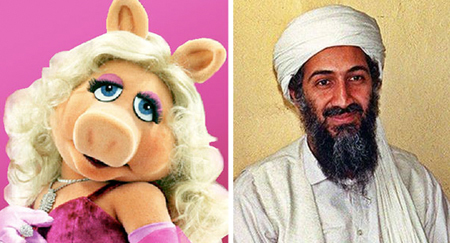
The study’s authors are at the University of Montana’s Cognitive Complexity Lab.
(Thanks to Neil Martin for bringing this to our attention.)

June 10, 2017
Dead Duck Day 2017, in pictures
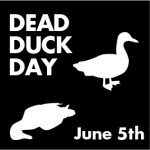 The 22nd edition of Dead Duck Day, honoring the mallard duck that became known to science as the first (documented) ‘victim’ of homosexual necrophilia in that species, on June 5th, 2017 attracted 85 spectators, a record number since 1996.
The 22nd edition of Dead Duck Day, honoring the mallard duck that became known to science as the first (documented) ‘victim’ of homosexual necrophilia in that species, on June 5th, 2017 attracted 85 spectators, a record number since 1996.
Right outside the Natural History Museum in Rotterdam, the ceremony included (1) the first posthumous public appearance of the world’s second officially homosexual necrophiliac duck (now a museum specimen), (2) The special ‘Dead Duck Day Message’, delivered in person by Henk Wolf who was hit in the eye by an Eurasian coot (Fulica atra) and who wrote the book ‘Een meerkoet in mijn oog‘ [A coot in my eye] about the dramatic consequences, and (3) the Moldavian poet Dumitru Crudu, poet-in-residence of the 48th Poetry International Festival Rotterdam, who read a poem about his encounters with ducks in Rotterdam.
Traditonally, Dead Duck Day also commemorated the billions of other birds that die(d) from colliding with glass buildings, and was topped off with a six-course duck dinner.
Here is a series of pictures, taken by Maarten Laupman, that captured the performers and the audience.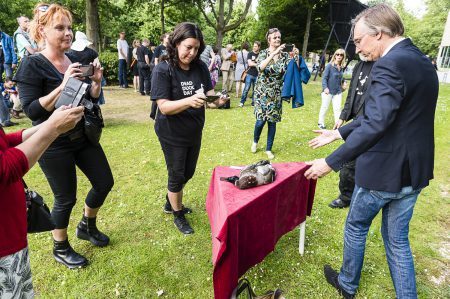
BONUS: Atlas Obscura’s report on Dead Duck Day.

June 9, 2017
Trees and drones — how will the tally turn out?
A new project, promoted by a beer company, offers a promotional video called “How drones are helping to plant trees“:
If successful, this project will to some extent offset the damage caused when drones crash into trees. Numerous videos document the phenomenon of drones crashing into trees. Here’s a video that compiles a very few of those very many crashes:

Eating Popcorn in Front of a Mirror May Induce Some People to Eat More Popcorn
Eating popcorn in front of a mirror is a provocative act — provoking the urge to eat more popcorn — suggests this study:
“The ‘Social’ Facilitation of Eating Without the Presence of Others: Self-reflection on Eating Makes Food Taste Better and People Eat More,” Ryuzaburo Nakata and Nobuyuki Kawai, Physiology and Behavior, epub 2017. The authors, at Nagoya University, Japan, explain:
“Food tastes better and people eat more of it when eaten with company than alone. Although several explanations have been proposed for this social facilitation of eating, they share the basic assumption that this phenomenon is achieved by the existence of co-eating others. Here, we demonstrate a similar “social” facilitation of eating in the absence of other individuals. Elderly participants tasted a piece of popcorn alone while in front of a mirror (which reflects the participant themselves eating popcorn) or in front of a wall-reflecting monitor, and were found to eat more popcorn and rate it better tasting in the self-reflecting condition than in the monitor condition. Similar results were found for younger adults. The results suggest that the social facilitation of eating does not necessarily require the presence of another individual. Furthermore, we observed a similar “social” facilitation of eating even when participants ate a piece of popcorn in front of a static picture of themselves eating,”
The university published an illustrative press release, which features this clarifying illustration: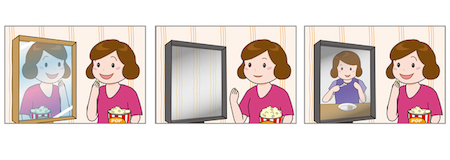 (Thanks to Tony Tweedale for bringing this to our attention.)
(Thanks to Tony Tweedale for bringing this to our attention.)

A man describing coffee descriptors for an hour and a half
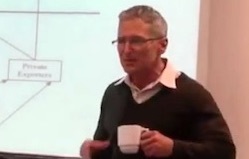 This is a rare 90-minute-long video of an emeritus professor describing coffee descriptors.
This is a rare 90-minute-long video of an emeritus professor describing coffee descriptors.
If you are not sure what a coffee descriptor is, you have 90 minutes in which to figure that out. After that, you are free to continue the effort unassisted:
BONUS: Professor Kenneth Liberman, of coffee descriptor descriptions fame, describes “turn-taking in the surfers’ lineup“.

June 8, 2017
The effects of artificial bird beak extensions – (new study)
If one were to superglue an artificial beak extension [see diagram] onto the bills of pigeons and crows, which of the species would best adapt?
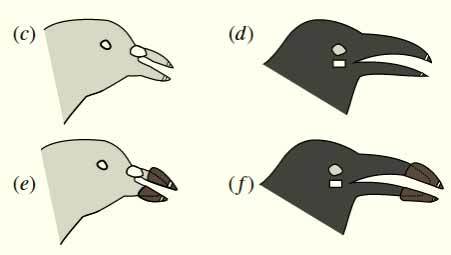 Answers are to be found in a new experimental study from Hiroshi Matsui (Department of Psychology, Keio University, Japan) and Ei-Ichi Izawa (Japan Society of Promotion for Sciences, Tokyo).
Answers are to be found in a new experimental study from Hiroshi Matsui (Department of Psychology, Keio University, Japan) and Ei-Ichi Izawa (Japan Society of Promotion for Sciences, Tokyo).
And may be summarised thus :
“In conclusion, our present study revealed that crows are capable of rapid motor adjustment of pecking to bill extension, but pigeons are not, although they possessed plasticity in a form of motor adaptation. These contrasting results of sensorimotor flexibility to body-part extension suggest different mechanisms underpinning pecking control between pigeons and crows: feed-forward and offline feedback control in pigeons and, presumably, online feedback control in crows.”
See: Flexible motor adjustment of pecking with an artificially extended bill in crows but not in pigeons, R. Soc. Open Sci. 4 : 160796, Feb. 2017.

June 7, 2017
Cinnamon to Induce Browning in the Fat of Fat Persons
A conjunction of thoughts might lead to the attempt at browning the fat of fat persons, if the results of this study hold sway:
“Cinnamon induces browning in subcutaneous adipocytes,” Hiu Yee Kwan, Jiahui Wu, Tao Su, Xiao-Juan Chao, Bin Liu, Xiuqiong Fu, Chi Leung Chan, Rebecca Hiu Ying Lau, Anfernee Kai Wing Tse, Quan Bin Han, Wang Fun Fong and Zhi-ling Yu, Scientific Reports, vol. 7, article no. 2447, 2017. 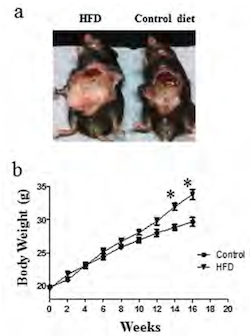
The study includes photos of two flayed, dead mice.
The authors, at Hong Kong Baptist University, HKBU Shenzhen Research Institute and Continuing Education, Guangzhou Institute of Cardiovascular Disease, Guangzhou Key Laboratory of Cardiovascular Disease, and Guangzhou Medical University, explain:
“Browning is the process of increasing the number of brite cells, which helps to increase energy expenditure and reduce obesity. Consumption of natural and non-toxic herbal extracts that possess the browning effect is an attractive anti-obesity strategy. In this study, we examined the browning effect of cinnamon extract [CE]…. [Our] data suggest that CE has a browning effect in subcutaneous adipocytes. Our study [which involved fat mice] suggests a natural non-toxic herbal remedy to reduce obesity [in fat humans].”
(Thanks to Tony Tweedale for bringing this to our attention.)
BONUS: “What are subcutaneous adipocytes really good for?”
BONUS: A purveyor of subcutaneous adipocytes.

June 6, 2017
Jumping spiders and the moon, dung beetles and the Milky Way
A report called “Tiny Jumping Spiders Can See the Moon” suggests that tiny jumping spiders can see the moon. The article does not suggest what, if any use the spiders might make of seeing the moon, if and when they do see it. (The article does explore the spiders’ ability to see glowing dots produced by laser pointers.)
Perhaps, perhaps there is some relation, or some sort, of this to the Ig Nobel Prize-winning study “Dung beetles use the Milky Way for orientation“.
BONUS: “Capuchin monkeys (Cebus apella) use a laser pointer to indicate distal objects“

Marc Abrahams's Blog
- Marc Abrahams's profile
- 14 followers


